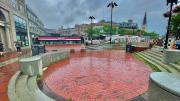On a hot June afternoon, the Harvard Square Pit was quiet. In the submerged hangout spot beside the entrance to the MBTA’s Red Line station, pigeons outnumbered people even as commuters whizzed to and from work. Soon, these passersby will be staring at fences: in early July, the city of Cambridge will begin demolishing the Pit, a famous eighties and nineties enclave for free spirits, misfits, castaways, and those craving some spontaneous companionship.
The scene was a stark contrast to the “Pit-A-Palooza” festivities held a few days earlier on June 25. At the Saturday evening celebration of the popular counterculture locale, hosted (perhaps surprisingly) by the city of Cambridge and Harvard Square Business Association (HSBA), guests moshed to punk music, smoked marijuana, and reminisced about a spot that had served such a big part of their lives.
Cambridge City Councilor Marc McGovern, who helped organize the event, remembered hanging out in the Pit in 1983 as a 14-year-old “pseudo punk rocker” who donned spike hair, a leather jacket, and combat boots. “And so I gravitated to that scene,” he says in an interview. “I spent a lot of hours in that pit.” The “Pit kids” or “Pit rats” he encountered varied widely in background. Some were homeless or estranged from their families. Others were dropped off by parents in BMWs and searched for a sense of community they couldn’t find at school. “Everybody sort of came together there,” he recalls, “which is what made it so interesting.” Author Jen Deaderick, another co-host of the event, often visited the Pit from her childhood home in Brookline. She stressed how important the spot was for teenagers at a time with no cell phones. “If you wanted to find your friends, you would just go to a place where your friends already hung out,” she says. “And so that was what the Pit was.”
Often, the Pit community provided support to those who really needed it. When a group tried to jump McGovern in Harvard Square, some of the older “Pit kids” told the group to leave him alone. “I ended up becoming friends with them over the years—and still am friends with them,” he says. “And so, that was something that always stuck out for me—feeling like, ‘Okay, I do kind of belong here.’” Many resonate with that feeling of belonging. A Facebook page dedicated to the Harvard Pit has grown to more than 2,000 members since its creation in 2020; in the last month alone, members have shared hundreds of stories, photos, and videos of a place that held great importance for them.
While the Pit was a supportive place for many, a joint statement from the HSBA and the City of Cambridge reminded readers that the Pit was not always a safe place. “Some of the [Pit] rats were victims of violence and sexual assault,” the statement reads, “and their experiences are the dark side of this otherwise positive experience.” In 2001, gang members sexually assaulted and murdered 22-year-old Io Nachtwey, a homeless woman from Hawaii, and tried to recruit Pit kids into an organized crime ring. “It’s important to acknowledge that it wasn’t all good,” McGovern says. “There were a lot of people who had really traumatic experiences there.”
Now, the sunken hangout spot will be replaced with a more level plaza with ample seating that will bring the area into compliance with the Americans with Disabilities Act. Denise Jillson, executive director of the HSBA, says the idea has been in the works since 2011, when her organization asked a landscape architect to help restore the famous Harvard Square Kiosk (which is protected by its listing on the National Register of Historic Places) and the surrounding area. They approached the Cambridge City Council in 2012 with more of a vision than a precise plan. Nearly a decade later, in 2021, with $8.3 million in funding from the city, work on the kiosk began. (It is no longer home to Out of Town News, and is in fact being converted into a visitor center—to the regret of newsstand patrons.) She says construction on the Pit will begin within the first two weeks of July—not long after the Pit-A-Palooza event.
As a result, the plaza will be out of commission for a while; she predicts between 18 and 24 months. (The City estimates a completion date in November 2022 for the kiosk and 2023 for the plaza.) McGovern looks forward to the changes. “I hope that [the construction] gets the area back to being a place where people gather,” he says. “It really hasn’t been that for a long time.”









